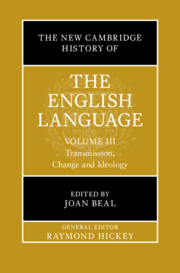Book contents
- The New Cambridge History of the English Language
- The New Cambridge History of the English Language
- The New Cambridge History of the English Language
- Copyright page
- Contents
- Figures
- Tables
- Contributors to Volume III
- General Preface
- Abbreviations
- General Editor’s Introduction
- Introduction to Volume III
- Part I The Transmission of English
- 1 Dictionaries in the History of English
- 2 Writing Grammars for English
- 3 Speech Representation in the History of English
- 4 Digital Interaction in the History of English
- 5 Internet Resources for the History of English
- Part II Tracking Change in the History of English
- Part III Ideology, Society and the History of English
- Index
- References
4 - Digital Interaction in the History of English
from Part I - The Transmission of English
Published online by Cambridge University Press: 23 October 2025
- The New Cambridge History of the English Language
- The New Cambridge History of the English Language
- The New Cambridge History of the English Language
- Copyright page
- Contents
- Figures
- Tables
- Contributors to Volume III
- General Preface
- Abbreviations
- General Editor’s Introduction
- Introduction to Volume III
- Part I The Transmission of English
- 1 Dictionaries in the History of English
- 2 Writing Grammars for English
- 3 Speech Representation in the History of English
- 4 Digital Interaction in the History of English
- 5 Internet Resources for the History of English
- Part II Tracking Change in the History of English
- Part III Ideology, Society and the History of English
- Index
- References
Summary
Our focus on digital interaction in the history of English foregrounds the mutually transformative relationship between language and society, with technological affordances enabling (new) forms of social interaction, whilst impeding or remediating (older) communication practices. Early internet forum users maximised meaning-making with available linguistic resources, including pre-digital typographical and respelling practices. Today, within the diversity of digital Englishes, strategies typical of early digital interaction remain, reconfigured for users’ local language ideologies and community norms and expanded to incorporate multilingual practices and new semiotic modes. This chapter explores the sociopragmatic practices of identity and belonging across the digital age, from Usenet in the 1980s and SMS in the 2000s to Twitter in the 2020s, detailing a complex interplay between new communicative opportunities and long-established sociopragmatic practices originating offline. Our analysis points to a diversification of English-using internet users and an expansion of multilingual, multimodal repertoires which prompt a revisiting of traditional sociolinguistic conceptions of English.
Information
- Type
- Chapter
- Information
- The New Cambridge History of the English LanguageTransmission, Change and Ideology, pp. 107 - 136Publisher: Cambridge University PressPrint publication year: 2025
References
Accessibility standard: WCAG 2.0 A
Why this information is here
This section outlines the accessibility features of this content - including support for screen readers, full keyboard navigation and high-contrast display options. This may not be relevant for you.Accessibility Information
Content Navigation
Allows you to navigate directly to chapters, sections, or non‐text items through a linked table of contents, reducing the need for extensive scrolling.
Provides an interactive index, letting you go straight to where a term or subject appears in the text without manual searching.
Reading Order & Textual Equivalents
You will encounter all content (including footnotes, captions, etc.) in a clear, sequential flow, making it easier to follow with assistive tools like screen readers.
You get concise descriptions (for images, charts, or media clips), ensuring you do not miss crucial information when visual or audio elements are not accessible.
You get more than just short alt text: you have comprehensive text equivalents, transcripts, captions, or audio descriptions for substantial non‐text content, which is especially helpful for complex visuals or multimedia.
Visual Accessibility
You will still understand key ideas or prompts without relying solely on colour, which is especially helpful if you have colour vision deficiencies.
Structural and Technical Features
You gain clarity from ARIA (Accessible Rich Internet Applications) roles and attributes, as they help assistive technologies interpret how each part of the content functions.
